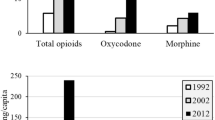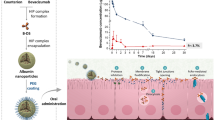Abstract
Purpose. To elucidate the effects of drug interactions on the urinary excretion of trientine in rats.
Methods. Trientine and various other drugs were intravenously administered to rats and the urinary excretion of trientine was investigated. To clarify the mechanisms of drug-drug interactions, we also investigated the effects of various drugs on spermine uptake by rat renal brush-border membrane vesicles.
Results. Cimetidine, a substrate of the H+/organic cation antiporter, and aminoglycoside antibiotics did not affect trientine excretion, while acetazolamide and furosemide, which increase the concentration of sodium ions in renal proximal tubules, increased the excretion of trientine. However, trichlormethiazide, which acts in renal distal tubules, did not affect trientine excretion. Acetazolamide and furosemide did not directly affect the Na+/spermine transporter because these diuretics had no effect on the uptake of spermine into the rat renal brush-border membrane vesicles.
Conclusions. There is no interaction between trientine and the substrate of the H+/organic cation antiporter or aminoglycoside antibiotics. However, drugs that change the concentration of sodium ions in renal proximal tubules, such as diuretics, can increase the trientine excretion since the increase in the luminal concentration of sodium ion accelerates the Na+/spermine antiporter.
Similar content being viewed by others
REFERENCES
I. H. Scheinberg and I. Sternlieb. Wilson's Disease, Saunders, Philadelphia, 1984.
C. D. Marsden. Wilson's disease. Quart. J. Med. 248:959-966 (1987).
J. M. Walshe. Treatment of Wilson's disease with trientine (triethylenetetramine) dihydrochloride. Lancet. I:643-647 (1982).
M. Kobayashi, R. Tanabe, M. Sugawara, K. Iseki, and K. Miyazaki. The mechanism of excretion of trientine from the rat kidney: Trientine is not recognized by the H+/organic cation transporter. J. Pharm. Pharmacol. 49:426-429 (1997).
M. Kobayashi, H. Fujisaki, M. Sugawara, K. Iseki, and K. Miyazaki. The presence of an Na+/spermine antiporter in the rat renal brush-border membrane. J. Pharm. Pharmacol. 51:279-284 (1999).
J. Biber, B. Stieger, H. Hasse, and H. Murer. A high yield preparation for rat kidney brush-border membranes. Different behavior of lysosomal markers. Biochim. Biophys. Acta. 647:169-176 (1981).
K. Miyazaki, S. Kishino, M. Kobayashi, S. Arashima, S. Matsumoto, and T. Arita. Determination of triethylenetetramine in plasma of patients by high-performance liquid chromatography. Chem. Pharm. Bull. 38:1035-1038 (1990).
R. Tanabe, M. Kobayashi, M. Sugawara, K. Iseki, and K. Miyazaki. Uptake mechanism of trientine by rat intestinal brush-border membrane vesicles. J. Pharm. Pharmacol. 48:517-521 (1996).
O. H. Lowry, N. J. Rosebrough, A. L. Farr, and R. J. Randall. Protein measurement with the Folin phenol regent. J. Biol. Chem. 193:265-275 (1951).
E. K. Jackson. Diuretics. In J. G. Hardman, A. Goodman Gilman, and L. E. Limbird (eds.), Goodman & Gilman's The Pharmacological Basis of Therapeutics (9th ed.), McGraw-Hill, New York, 1996, pp. 685-713.
M. Takano, K. Inui, T. Okano, and R. Hori. Cimetidine transport in rat renal brush-border and basolateral membrane vesicles. Life Sci. 37:1579-1585 (1985).
D. H. Russell, C. C. Levy, S. C. Schimpff, and I. A. Hawk. Urinary polyamines in cancer patients. Cancer Res. 31:1555-1558 (1971).
T. P. Waalkes, C. W. Gehrke, D. C. Tormey, R. W. Zumwalt, J. N. Hueser, K. C. Kuo, D. B. Lakings, D. L. Ahmann, and C. G. Moertel. Urinary excretion of polyamines by patients with advanced malignancy. Cancer Chemother. Reports-Part 1. 59:1103-1116 (1975).
C. Loser, U. R. Folsch, C. Paprotny, and W. Creutzfeldt. Polyamines in colorectal cancer. Evaluation of polyamine concentrations in the colon tissue, serum, and urine of 50 patients with colorectal cancer. Cancer 65:958-966 (1990).
S. Silbernagl, K. Völker, H. J. Lang, and W. H. Dantzler. Taurine reabsorption by a carrier interacting with furosemide in short and long Henle's loops of rat nephrons. Am. J. Physiol. 272:F205-F213 (1997).
F. G. Knox, F. S. Wright, S. S. Howards, and R. W. Berliner. Effect of furosemide on sodium reabsorption by proximal tubule on the dog. Am. J. Physiol. 217:192-198 (1969).
B. M. Brenner, R. I. Keimowits, F. S. Wright, and R. W. Berliner. An inhibitory effect of furosemide on sodium reabsorption by the proximal tubule of the rat nephron. J. Clin. Invest. 48:290-300 (1969).
Author information
Authors and Affiliations
Rights and permissions
About this article
Cite this article
Kobayashi, M., Fujisaki, H., Sugawara, M. et al. Effects of Interactions Between Drugs on the Renal Excretion of Trientine in Rats—Acetazolamide and Furosemide Increase Trientine Excretion. Pharm Res 16, 1888–1892 (1999). https://doi.org/10.1023/A:1018963712232
Issue Date:
DOI: https://doi.org/10.1023/A:1018963712232




